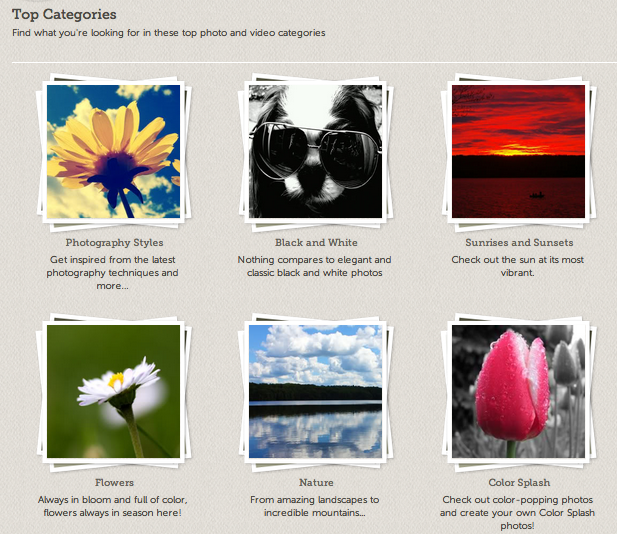Photobucket is one of the oldest sites dedicated to photo and video sharing — and, at 100 million users, and 3.5 billion images served per day, and 10 billion photos stored — one of the biggest. But with the rise of other photo sharing and storage options from Facebook (955 monthly active users), Twitter (500m registered users), Instagram, Yfrog and so many more, its position as a go-to place for storing and sharing images has eroded. Now the company wants to tacle that head-on with a new redesign that upgrades the user experience with new look, better uploading and a new social feature called Photobucket Stories that creates Timeline-like narratives that friends can use collaboratively to create image-based recollections of an event.
The changes could not come a moment too soon. It was only a week ago that Photobucket landed in the news with a story about how dodgy “fuskers” were using sneaky programs to mine private photos on the site and nude ones to Reddit and other sites. If that wasn’t bad enough, the follow up question that this story raised, “Remember Photobucket?” kind of says it all about how some regard Photobucket’s relevance today.
And with a possibly reinvigorated Flickr coming onto the scene, and a Facebook redoubled with an Instagram acquisition, the time is ripe for Photobucket to update.
Tom Munro, Photobucket’s CEO, points out that there is now a gap in the market that Photobucket wants to fill: the world now has too many ways to take pictures and too many places to store them. People now need a site that can provide some kind of “defragmentation” function.
“Everyone has a phone in their pocket, many also still use cameras, and sometimes more than one,” he points out. “But only half of us back up pictures on a regular basis.” And when we do, it’s often in a mish-mash of places: our hardrives, the cloud-storage services provided by third parties like Facebook and Instagram, and more.
He cites a recent study from InfoTrends that showed that 45% of respondents said they have lost digital pictures, “and that number has been climbing every year. Management is becoming a big challenge.”
The idea behind the new Photobucket is to take away some of that hardship. New desktop uploaders have been created that complement an automated uploading service that is already available on Photobucket’s mobile apps.
While users will still have to make the decision to upload pictures to Photobucket, and then manually select which ones to upload, there is still a lot left to human laziness and disorganization. So where Photobucket’s unification principle might come into play best is in the new Stories feature.
Stories will only get turned on in September, after the launch of the beta, but it’s an interesting idea: users can collaborate together on a communal pinboard — or “canvas”, as Photobucket calls it — contributing their own pictures, video and text, to form part of larger narratives with those of their friends. Again, the aim is to bring good pictures out into the light and bring them together with other people’s relevant pictures.
“Our phones have become the equivalent of a shoebox,” he says, referring to how people have stored printed pictures for years before the move to digital devices, where the vast majority no longer get printed. “We take so many, but we may share one or two and the rest we forget about. This is about trying to bring these out and together,” says Munro.
These pictures can come from any other source — your own phone or camera, or another third-party site — but with the Stories they all get consolidated into one place, and under one theme or event. Munro notes that any pictures from the Stories automatically get copied into a user’s photo database as well.
These Stories will also be another way for Photobucket to extend itself outside of its own walled garden. People will be able to post Stories, for example, on their Facebook Timelines. For now, the idea is that clicking on these will take you to the Photobucket site, but Munro notes that it is currently working with Facebook on ways of either consuming them in-line in the Timeline — and possibly creating a separate Facebook app to improve the experience even further.
Photobucket is different from many other photo-sharing sites in that it has built out its own server infrastructure — it doesn’t rely on Amazon or anyone else. That was one unique selling point when Photobucket won its deal with Twitter — the site powers all of Twitter’s photo and video clips (the traffic that this deal generates is confidential and not calculated as part of Photobucket’s stated traffic numbers). Whether that is the best way forward is another question. “We might have done things differently if we were creating the service from scratch today,” Munro admitted.
But that has possibly also given the company a lot more flexibility in how it’s approached its monetization model. To date, Photobucket has been a primarily free site, and that will not change in the upgrade. In fact, the consumer-facing site makes most of its money from advertising that runs alongside the photo service, so it needs all the traffic it can get. But it is also starting to introduce more paid, tiers now, too.
“Photobucket has been a free site,” Munro says, “and we will continue to have a great free service for users, but when a certain threshold is hit users will have to subscribe.”
The site will have a 2 gigabyte threshold for free images, which Munro says was decided based on historical use of the site — most users store less than this. Photobucket will charge a fee of $29.99 annually for more pictures up to 20 gigabytes. Tiers above that, he says, are “competitively priced.”
Photobucket has also given TechCrunch some codes for the new beta version. The first 50 to click here get in without having to queue.
And as for the fuskers, Photobucket still doesn’t seem to have put any new controls in place to prevent this, but it is trying to make more of an effort to communicate to users how they be more proactive in making sure their images don’t get abused in this way. The problem is more, it seems, about legacy, neglected uploads than active users, although if this redesign works as Photobucket hopes, it will have significantly less dormant users in future than it perhaps has today.

